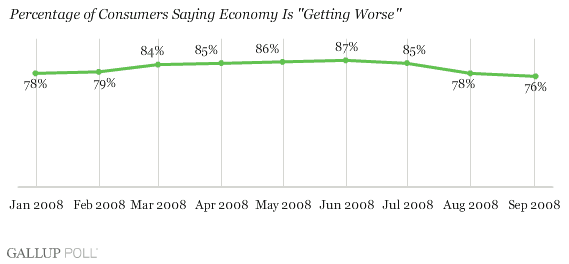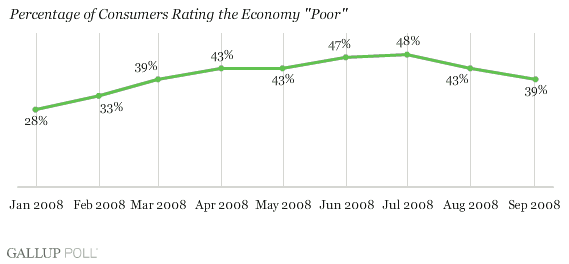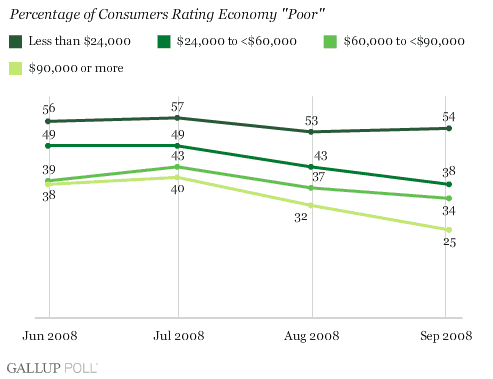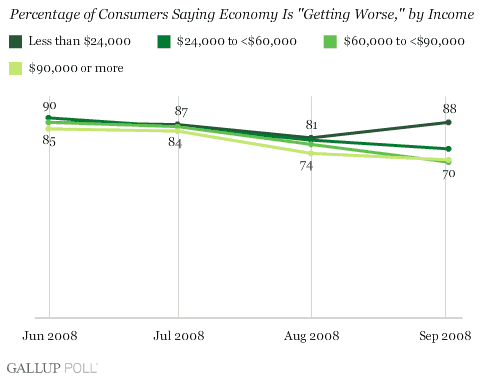PRINCETON, NJ -- Falling gas prices seem to have more than offset rising unemployment in recent months, as the percentage of Americans saying current economic conditions are getting worse declined from its June peak of 87% to 85% in July and 78% in August. During the first week of September and even after the August surge in the unemployment rate to 6.1%, this measure of consumer pessimism moderated further to 76%.

Pessimism Continues to Ease in Early September
On Friday, the University of Michigan will release its preliminary Index of Consumer Sentiment for September. ║┌┴¤═° Poll Daily tracking of consumer perceptions suggests that consumer sentiment actually improved in early September, although consumers remain highly negative about both the current condition of the U.S. economy and its future direction.
While three in four consumers continue to say the economy is headed in the wrong direction, this reflects less pessimism than at the beginning of the summer, when nearly 9 in 10 thought things were getting worse, not better. At the same time, the percentage of Americans rating the economy "poor" also declined, to 39% from 43% in August and 48% in July.

Consumers Perceptions by Income
Consumers' ratings of the current economy and their expectations for its future course improved across all but the lowest income group during the first week of September. The percentage of upper-income consumers rating the economy as "poor" fell from 40% in July to 32% in August and now stands at 25% in the first week of September. Smaller but significant reductions have also taken place in the percentage of middle-income consumers rating the economy poor between July and early September. However, 54% of lower-income Americans rate the economy as poor -- little changed from July and August.

Similarly, the percentage of upper- and middle-income Americans saying the economy is getting worse also declined in early September. In contrast, the percentage of lower-income Americans holding this view bounced back up to 88% in early September after declining in August.

Commentary
Given falling gas prices at the pump, it is not surprising that over the past couple of months, some Americans have become less pessimistic about the U.S. economy and its future course. And with John McCain, Sarah Palin, and the rest of the Republican Party not making economic woes a centerpiece of their convention as the Democrats did, this may have further reduced consumer pessimism in early September.
On the other hand, the uptick in pessimism in early September among lower-income Americans is troubling. This could be simply an aberration, but it may instead presage another negative for consumer confidence: rising unemployment. The Bureau of Labor Statistics' Friday announcement that the U.S. unemployment rate hit a five-year high in August suggests unemployment concerns may soon join continued high gas prices as major drivers of consumer pessimism. So far, ║┌┴¤═°'s overall consumer confidence measures do not seem to have taken a turn for the worse since the unemployment numbers were released on Friday.
In this regard, the bailout of Fannie Mae and Freddie Mac this weekend is somewhat mixed news for the American consumer. The need to put these companies into federal receivership reflects that conditions remain bleak in the nation's housing and mortgage finance sectors. On the other hand, the bailout itself provides some hope that the housing market and housing prices may begin stabilizing soon.
Over the next eight weeks of the presidential election, Americans are going to be subjected to a continuous barrage of negative comments about the nation's economic difficulties. This is likely to combine with rising unemployment concerns to bring an end to the recent reductions in consumer pessimism. The question going forward is whether enthusiasm about the potential for change and a new economic direction as proposed by the candidates can turn consumer perceptions around significantly in the months ahead.
Survey Methods
║┌┴¤═° is interviewing no fewer than 1,000 U.S. adults nationwide each day during 2008. The economic questions analyzed in this report are asked of a random half-sample of respondents each day. The results reported here are based on combined data of more than 8,000 interviews each month, from January through August. For results based on this sample, the maximum margin of sampling error is ┬▒1 percentage point.
The questions for September are based on combined data of more than 3,000 interviews conducted Sept. 1-6, 2008. For results based on this sample, the maximum margin of sampling error is ┬▒2 percentage points.
Interviews are conducted with respondents on land-line telephones (for respondents with a land-line telephone) and cellular phones (for respondents who are cell-phone only).
In addition to sampling error, question wording and practical difficulties in conducting surveys can introduce error or bias into the findings of public opinion polls.
To provide feedback or suggestions about how to improve ║┌┴¤═°.com, please e-mail feedback@gallup.com.
